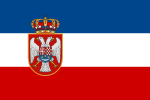Yugoslav Royal Navy
| Royal Yugoslav Navy | |
|---|---|
| Active | 1921–1945 |
| Country |
|
| Type | Navy |
| Role | Coastal defence |
| Size | 41 combatants 19 auxiliaries 150 seaplanes (1941) |
| Part of | Royal Yugoslav Armed Forces |
| Engagements | |
| Commanders | |
| Notable commanders |
Dragutin Prica |
| Insignia | |
| Naval Ensign (1922–1941) |  |
| Naval Ensign (1918–1922) |  |
The Royal Yugoslav Navy (Serbo-Croatian: Kraljevska Jugoslavenska Ratna Mornarica, Кpaљeвcкa Југословенска Pатна Морнарица; KJRM), was the navy of the Kingdom of Yugoslavia, and existed between 1921 and 1945. It was brought into existence as the navy of the Kingdom of Serbs, Croats and Slovenes, and initially consisted of a few former Austro-Hungarian Navy vessels surrendered at the conclusion of World War I and transferred to the new nation state in 1921 under the terms of the Treaty of Saint-Germain-en-Laye. The only modern sea-going warships transferred to the new state were twelve steam-powered torpedo boats, although it did receive four capable river monitors for use on the Danube and other large rivers. Significant new acquisitions began in 1926 with a former German light cruiser, followed by the commissioning of two motor torpedo boats (MTBs) and a small submarine flotilla over the next few years. When the name of the state was changed to Yugoslavia in 1929, the name of its navy was changed to reflect this. In the late 1920s, several of the original vessels were discarded.
Throughout the interwar period, elements of the fleet conducted visits to ports throughout the Mediterranean, but few fleet exercises occurred due to budget pressures. In 1930, the Maritime Air Force was divorced from Royal Yugoslav Army control, and the naval air arm began to develop significantly, including the establishment of bases along the Adriatic coast. The following year, a British-made flotilla leader was commissioned with the idea that the KJRM might be able to operate in the Mediterranean Sea alongside the British and French navies. In the same year, five locally-built minelayers were added to the fleet. A hiatus of several years followed, and it was not until 1936 that any further major acquisitions were made, with the purchase of eight German-built MTBs. Over the next two years, the fleet was significantly strengthened by the acquisition of three French-designed destroyers, marking the high point of Yugoslav naval strength. On the eve of World War II, the navy consisted of 611 officers and 8,562 men, operating 41 combatant ships and 19 auxiliaries.
...
Wikipedia
